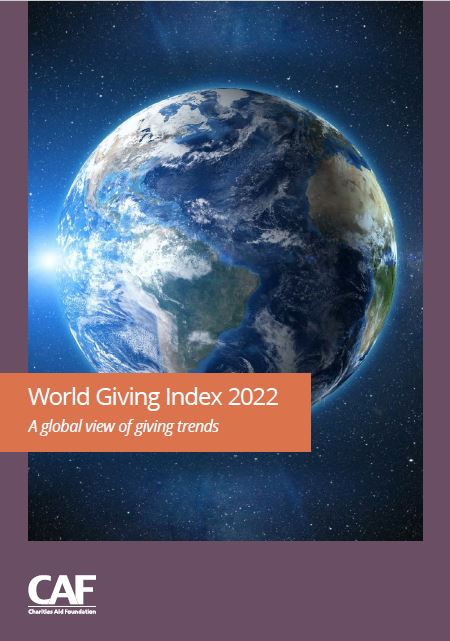What is this Report?
The report is an annual report that looks at global giving focusing on three areas: helping strangers, donating money to charity and volunteering time. The report has surveyed 1.95 million people since 2009. For 2022, CAF included data from 119 countries, which was 90%+ of the total adult population on the earth.
What are key findings from the article?
- Sixty-two percent of people reported they helped a stranger last year. This is up from 55% for 2020 and the highest percentage of people since the CAF report began.
- Thirty-five percent of individuals gave to charity in 2021.
- Low-to-middle income countries represent the majority of most generous countries in the top ten most generous list, a change from before the pandemic. In 2018, high income countries dominated with 7 out 10 countries in the most generous list. But in 2020, the number switched to 7 low-to middle income economies in the top ten. 2021 saw a rise in high income countries in the list but six out of ten are still classified as low-to middle income.
- Indonesia retains its top spot as the most generous country, fifth year in a row. Kenya is second most generous, followed by the United States, which has returned to the top ten list.
- The Ukraine is the only European country in the top ten most generous countries, jumping from 20 to 10 in 2022.
- Some countries may define charity differently from others, which may adversely reflect their scores. For instance, the report suggested that some countries who scored low on helping a stranger may have strong safety nets (France, Switzerland, etc.). Japan scored low on generosity but the report suggested that “what might be perceived as charity in the United States is likelier to be understood as responsibility in Japan.”
- The countries with the largest percentage of people donating money are the following:
- Indonesia -84%
- Myanmar – 73%
- Netherlands -68%
- Iceland – 67%
- United Kingdom – 65%
- Australia -64%
- Malta – 64%
- Thailand – 62%
- United States – 61%
- New Zealand – 61%
What can I do as a result?
- Remember that people can give in different ways and engage them. The CAF report breaks down generosity into helping a stranger, giving to charity, and volunteering. Sharise Harrison, Director of Prospect Management and Research at Loyola University Chicago, said it best in an interview with Aspire in 2022: “A good prospect is some institution, organization, or individual who is likely to be engaged, believes in your organization and will provide not only monetarily, but also volunteer time.”
- Specifically, review how you are engaging volunteers. Neon One reported that 53% of people who support a nonprofit decide to volunteer there; 39% volunteer first, then give to the nonprofit. How is your organization engaging with volunteers? And vice versa?
- Make sure to understand people in different countries understand giving and helping others. Some countries may see things as charitable that other countries don’t due to differences in perception. Like everything in philanthropy, it’s about creating relationships and making connections. Philanthropic culture is not the same everywhere.
- While organizations tend to target high income countries for international donations, the report suggests that low-to-middle income countries are stepping up their philanthropy. Everyone can find a way to contribute but they have to be respected and brought to the table.
- As always, ask for contributions! Even though most countries have reopened fully, generosity levels are still up. That suggests that more people see the need to help their fellow strangers.
Additional Resources
- Charities Aid Foundation: World Giving Index l CAF 2022
- Donors: Understanding The Future of Individual Giving l NeonOne 2022
- Interview with Sharise Harrison l Aspire Research Group 2022
